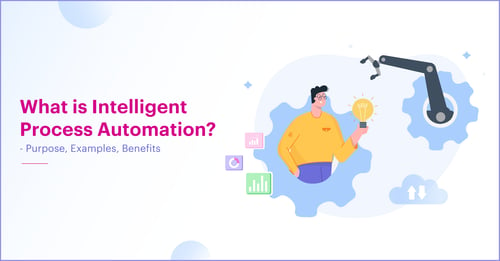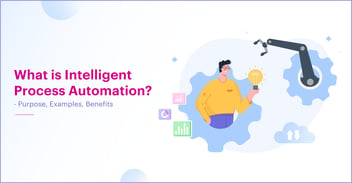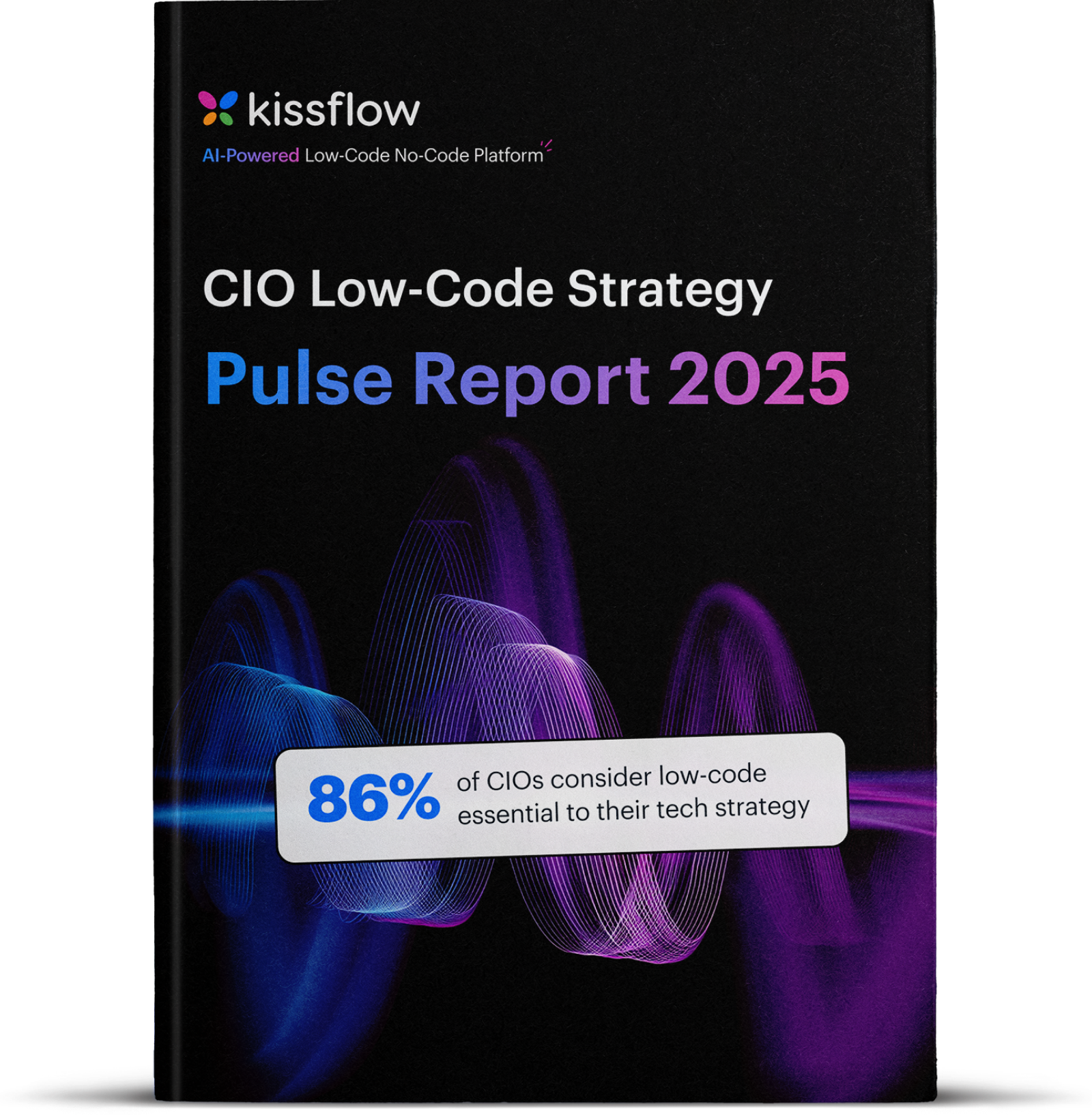
- >
- Workflow Platform>
- BPM Software>
- Intelligent Automation Guide
Intelligent Automation: Definition, Meaning, and Complete Guide
You're sitting in yet another quarterly review meeting, watching your team present metrics that look eerily similar to last quarter's numbers. Your competitors are moving faster, your customers expect more, and your best people are spending their days on mind-numbing repetitive tasks instead of driving innovation.
Sound familiar?
If you're a CIO, CTO, or any C-level executive wrestling with digital transformation, you're not alone. The pressure to do more with less while staying competitive has never been higher. That's where intelligent automation comes in—not as another buzzword to add to your already overflowing tech stack, but as a genuine game-changer that's reshaping how smart organizations operate.
In this guide, you'll discover what intelligent automation really means (spoiler: it's not just robots taking over), how it works in the real world, and why companies using intelligent process automation are leaving their competition in the dust. More importantly, you'll walk away with a clear roadmap for implementing these solutions in your organization without the usual tech headaches.
What is intelligent automation?
Intelligent automation combines artificial intelligence (AI), machine learning (ML), and robotic process automation (RPA) technologies to automate complex business processes, make cognitive decisions, and continuously improve performance. Unlike traditional automation that handles simple tasks, intelligent automation streamlines end-to-end workflows by integrating cognitive capabilities with process execution.
Here's the simple breakdown: intelligent automation combines three powerhouse technologies—artificial intelligence (AI), machine learning (ML), and robotic process automation (RPA)—to create systems that don't just automate tasks, they actually understand what they're doing and improve over time.
Think about it this way. Traditional automation is like a very efficient factory worker who can assemble the same widget perfectly every time, as long as nothing changes. Intelligent process automation? That's like having a factory supervisor who not only knows how to build the widget but can spot quality issues, suggest improvements, and even figure out how to build completely new widgets when needed.
Define intelligent automation in business terms
When we define intelligent automation for business leaders, we're talking about technology that can:
Process information like your best analyst
Make decisions based on data and rules
Learn from experience and get smarter over time
Handle exceptions without human intervention
Scale up or down based on demand
The automation technology's meaning goes beyond just "doing things faster." It's about creating digital workers that can handle complex, judgment-based tasks that traditionally required human expertise.
How intelligent automation provides value to enterprises
Now, let's talk about what intelligent automation provides that traditional automation can't. The difference isn't just incremental—it's transformational.
Speed without sacrifice
Your traditional processes might take days or weeks because they involve multiple handoffs, approvals, and manual reviews. Advanced process automation can compress these timelines from weeks to hours, and from hours to minutes, without compromising quality or compliance.
Accuracy that compounds
Human error rates in repetitive tasks typically hover around 1-3%. That might sound small, but when you're processing thousands of transactions, those errors add up fast. Smart automation systems can achieve accuracy rates above 99.5% and actually get better over time.
Insights you never knew existed
Here's where intelligent process automation gets interesting. As automated systems handle your processes, they're constantly collecting data and spotting patterns that humans might miss. Companies using these systems often discover inefficiencies they never knew existed and opportunities they never considered.
Compliance that never sleeps
Regulatory compliance isn't optional, but it's also not exciting work for your top talent. Automated compliance monitoring can track requirements 24/7, flag potential issues before they become problems, and maintain perfect audit trails without breaking a sweat.
Real-world intelligent automation examples
Let's move from theory to practice with some examples that show how this technology works in the real world.
Customer service transformation
Imagine Sarah, a fictional customer service director at a mid-size insurance company. Her team was drowning in routine inquiries about policy changes, claims status, and billing questions. The same questions, day after day, while complex cases sat in queues waiting for attention.
Sarah implemented an intelligent process automation solution that could:
Read and understand customer emails in natural language
Access policy databases and claims systems
Provide accurate, personalized responses
Escalate complex issues to human agents with full context
Result? Her team went from handling 200 cases per day to overseeing 2,000, with customer satisfaction scores jumping 40% because complex issues got immediate expert attention.
Financial operations overhaul
Consider Mike, a CFO at a growing manufacturing company (this is a fictional scenario to illustrate the concept). His finance team spent 60% of their time on invoice processing, expense reports, and reconciliation—work that required expertise but felt like intellectual waste.
His intelligent process automation included:
Scanning and extracting data from invoices in any format
Cross-referencing purchase orders and contracts
Identifying discrepancies and routing exceptions
Learning from each decision to improve accuracy
The transformation was dramatic. Processing time dropped from days to hours, error rates fell by 90%, and his finance team could finally focus on analysis and strategy instead of data entry.
HR and talent management revolution
Picture Jennifer, an HR director dealing with hundreds of job applications for each open position (again, a fictional example for clarity). Her team was spending weeks just screening resumes, while great candidates moved on to faster competitors.
Her AI-powered automation uses included:
Scanning resumes for relevant skills and experience
Ranking candidates based on job requirements
Scheduling interviews automatically
Tracking candidate progress and sending updates
Now her team reviews only the top 10% of candidates, time-to-hire dropped by 50%, and they're landing better talent because they can move quickly on top candidates.
What technology powers intelligent automation?
Understanding what technology powers these smart systems isn't just academic—it helps you make smarter decisions about implementation and vendor selection.
Artificial intelligence and machine learning
At its core, AI gives systems the ability to simulate human intelligence. Machine learning takes this a step further by allowing systems to improve their performance based on experience. Think of ML as the difference between a calculator (follows instructions) and a chess master (learns from every game).
Natural language processing (NLP)
This is what allows intelligent process automation systems to understand human language—not just keywords, but context, intent, and nuance. Advanced NLP can read contracts, understand customer complaints, and even detect emotional sentiment in communications.
Robotic process automation (RPA)
RPA handles the "doing" part—interacting with applications, moving data between systems, and executing tasks just like a human would, but faster and without errors.
Computer vision
This technology allows systems to "see" and interpret visual information. It can read documents, recognize faces, inspect products for quality, or even monitor workplace safety compliance.
Decision engines
These systems codify business rules and logic, allowing automated processes to make complex decisions based on multiple criteria and variables.
At Kissflow, we've seen companies struggle with point solutions that handle only one piece of this puzzle. The real magic happens when these technologies work together seamlessly in comprehensive intelligent process automation platforms, which is why integrated approaches are becoming the preferred choice for smart organizations.
Intelligent process automation vs traditional automation
Let's clear up some confusion around intelligent process automation and how it differs from what came before.
Traditional automation:
Rule-based, rigid, breaks when anything unexpected happens
Intelligent process automation:
Adaptive, learns from exceptions, handles variability
Traditional automation limitations
Your grandfather's automation worked great in predictable environments. Assembly lines, data entry, simple calculations—tasks with clear inputs and outputs. But throw in a curveball, and the whole system would grind to a halt waiting for human intervention.
Intelligent process automation meaning
When we define intelligent process automation, we're talking about systems that can:
Handle unstructured data (think emails, PDFs, handwritten forms)
Make judgment calls based on historical data
Adapt to new scenarios without reprogramming
Learn from human feedback and improve over time
The intelligent process automation meaning centers on flexibility and learning capability. Where traditional automation required perfect, predictable inputs, intelligent process automation thrives on real-world messiness.
A practical comparison
Let's say you're processing vendor invoices. Traditional automation might handle 70% of invoices—the ones that arrive in the expected format, with all required fields, matching existing purchase orders exactly.
Intelligent process automation can handle 95%+ of invoices by:
Reading invoices in any format (PDF, email, paper scan, Excel)
Extracting relevant data even when fields are in different locations
Cross-referencing against purchase orders with fuzzy matching
Learning from each exception to handle similar cases automatically next time
Aspect |
Traditional Automation |
Intelligent Process Automation |
|
Decision Making |
Rule-based, follows predetermined scripts |
AI-powered, makes contextual decisions and learns from data |
|
Data Handling |
Structured data only, fixed formats |
Unstructured and structured data, any format |
|
Adaptability |
Rigid, breaks when conditions change |
Adaptive, handles exceptions and variations automatically |
|
Learning Capability |
Static, requires manual updates |
Self-learning, improves performance over time |
|
Error Handling |
Stops at exceptions, requires human intervention |
Handles exceptions intelligently, learns from errors |
|
Complexity |
Simple, repetitive tasks only |
Complex, judgment-based processes |
|
Integration |
Point-to-point connections |
End-to-end workflow orchestration |
|
Scalability |
Linear scaling, performance degrades |
Intelligent scaling based on demand and patterns |
|
Maintenance |
High maintenance, frequent manual updates |
Self-optimizing, minimal maintenance required |
|
Process Coverage |
60-70% of standard processes |
90%+ including edge cases and variations |
|
Implementation |
Faster for simple tasks |
Longer initial setup but broader capability |
|
Cost Structure |
Lower upfront, higher ongoing maintenance |
Higher initial investment, lower total cost of ownership |
|
User Interface |
Technical, requires IT involvement |
No-code/low-code, business user friendly |
|
Analytics |
Basic reporting |
Advanced analytics with predictive insights |
Implementation strategies for intelligent automation
Rolling out these smart systems isn't like installing new software—it's more like bringing on a new team member who needs training, context, and gradual integration into your operations.
Start with process mapping
Before you automate anything, you need to understand what you're actually doing today. Map out your current processes, identify bottlenecks, and spot opportunities where intelligent process automation can make the biggest impact.
Look for processes that are:
High-volume and repetitive
Rule-based but require some judgment
Currently creating bottlenecks
Prone to human error
Time-sensitive
Choose your battles wisely
Not every process is a good candidate for intelligent process automation. Start with what we call "quick wins"—processes that are important enough to matter but simple enough to implement successfully.
Your first smart automation project should be visible enough that success gets noticed but contained enough that failure won't sink your initiative.
Build internal champions
Technology implementations succeed or fail based on people, not features. Identify team members who understand both the current processes and the potential of new technology. These champions will become your change agents when you're ready to scale.
Plan for change management
Here's something vendors won't tell you: the technology is often the easy part. The hard part is helping your team adapt to new ways of working. Be upfront about changes, involve affected team members in the design process, and celebrate early wins loudly.
Common challenges enterprise CEOs/CIOs face and how to overcome them
Every intelligent process automation initiative faces predictable challenges. Here's how smart leaders navigate them:
Data quality issues
Garbage in, garbage out—this rule is ironclad with smart automation. Before you implement anything, audit your data quality. Clean up inconsistencies, establish data governance, and create processes to maintain data integrity going forward.
Integration complexity
Your new process automation tools need to play nicely with existing systems. This is where platforms like Kissflow shine—they're built with integration in mind, reducing the technical complexity that derails many automation projects.
Resistance to change
Some team members will worry about job security or simply prefer familiar processes. Address these concerns head-on. Show how intelligent process automation frees them up for more strategic, interesting work rather than replacing them.
Unrealistic expectations
Smart automation is powerful, but it's not magic. Set realistic timelines, start with achievable goals, and communicate progress regularly. Small, consistent wins build momentum better than grand promises that fall short.
Measuring success with intelligent automation
You can't manage what you don't measure. Here are the key metrics that matter for intelligent process automation initiatives:
Operational metrics
-
Processing time reduction: How much faster are processes completing?
-
Error rate improvement: What's the quality impact?
-
Volume capacity: How much more work can you handle with the same team?
-
Exception handling: What percentage of cases require human intervention?
Business impact metrics
-
Cost per transaction: What's the unit economics improvement?
-
Customer satisfaction: Are customers happier with faster, more accurate service?
-
Employee satisfaction: Are your people more engaged with higher-value work?
-
Revenue impact: Can you connect automation improvements to business results?
Strategic metrics
-
Time to market: Are you delivering new products/services faster?
-
Competitive advantage: Are you outpacing competitors in key areas?
-
Innovation capacity: Is your team focusing more on strategic initiatives?
The future of intelligent automation
Where is all this heading? The trends are clear, and they're accelerating faster than most organizations realize.
Hyperautomation is coming
Soon, entire business processes will run end-to-end without human intervention. We're talking about supply chain management, financial reporting, customer onboarding—complex workflows that currently require multiple teams and weeks of work.
AI is getting smarter
Today's intelligent process automation systems are impressive. Tomorrow's will be transformational. Natural language processing is approaching human-level comprehension, computer vision can outperform human experts in many domains, and decision-making algorithms are becoming more sophisticated every month.
No-code/low-code integration
The technical barriers to implementing intelligent process automation are disappearing. Modern platforms allow business users to design and deploy smart automation solutions without traditional IT bottlenecks.
Industry-specific solutions
Generic automation tools are giving way to industry-specific intelligent process automation solutions that understand the unique challenges and regulations of different sectors. Healthcare, financial services, manufacturing—each has specific needs that tailored process automation addresses more precisely.
Getting started: Your intelligent automation roadmap
Ready to move from reading about intelligent process automation to actually implementing it? Here's your step-by-step roadmap:
Phase 1: Assessment and planning
-
Process audit: Document current workflows and identify automation opportunities
-
Technology assessment: Evaluate your current systems and integration requirements
-
Team readiness: Assess change management needs and identify champions
-
ROI modeling: Build business cases for your top intelligent process automation candidates
Phase 2: Pilot implementation
-
Select pilot process: Choose a high-impact, manageable first automation project
-
Technology selection: Choose platforms and partners that align with your long-term intelligent process automation vision
-
Implementation: Deploy your first automation solution
-
Measurement: Track results and gather lessons learned
Phase 3: Scale and optimize
-
Expand scope: Apply learnings to additional processes
-
Integration: Connect automated processes for end-to-end workflow optimization
-
Continuous improvement: Use data and feedback to refine and enhance performance
-
Strategic planning: Develop long-term automation roadmap
Conclusion: Your competitive advantage awaits
The companies winning in today's market aren't necessarily the ones with the biggest budgets or the most people. They're the ones moving fastest, serving customers better, and freeing their best talent to focus on what humans do best—strategy, creativity, and complex problem-solving.
Intelligent process automation isn't just about efficiency anymore. It's about competitive survival.
While your competitors are still debating whether to modernize their operations, you could be implementing smart automation solutions that transform how work gets done. The question isn't whether intelligent process automation will reshape your industry—it's whether you'll be leading that transformation or scrambling to catch up.
Ready to see what intelligent process automation can do for your organization?
Kissflow has helped hundreds of companies implement intelligent automation solutions that deliver real results, not just fancy demos. Our platform combines the power of AI, machine learning, and process automation in a single, integrated solution that works with your existing systems and grows with your needs
Unlike point solutions that solve one piece of the puzzle, Kissflow provides end-to-end intelligent process automation that connects your entire operation. From simple task automation to complex decision-making workflows, our platform adapts to your business rather than forcing your business to adapt to technology limitations.
The best part? You can see results in weeks, not months. Our no-code approach means your team can design, test, and deploy intelligent automation solutions without IT bottlenecks or consultant dependencies.
Don't let another quarter pass watching competitors gain ground. Schedule a personalized demo today and discover how Kissflow can transform your operations with intelligent process automation that actually works in the real world.
Frequently Asked Questions
Traditional RPA follows fixed rules and breaks when anything unexpected happens. Intelligent automation uses AI and machine learning to handle unstructured data, make decisions, and learn from exceptions. While RPA might process 70% of invoices, intelligent process automation can handle 95%+ because it adapts to different formats and learns over time.
Most organizations see results within 3-6 months, with full ROI in 12-18 months. Simple processes like data entry show immediate benefits, while complex workflows take longer but deliver higher returns. Starting with high-impact, manageable processes accelerates results.
No, it augments your team rather than replacing them. Your employees get promoted from repetitive tasks to strategic work—analysis instead of data entry, complex problem-solving instead of routine questions. You handle more volume with the same team while creating higher-value roles.
Look for high-volume, rule-based processes that require some judgment and involve multiple systems. Examples include invoice processing, customer onboarding, resume screening, and financial reporting. Avoid highly creative work, frequently changing processes, or one-off activities.
Focus on integration capabilities, no-code features, true AI/ML capabilities, scalability, and total cost of ownership. Choose platforms like Kissflow that combine everything in one solution rather than requiring multiple point solutions. Look for partners who understand your industry and support long-term growth.
Start your intelligent automation journey with Kissflow today
Get Started
Related Articles











